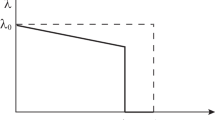Abstract
In this paper, a new analytical method for solving stable crack propagation problems in a ductile panel with a row of cracks, is presented. The main purpose of the present study is to estimate the maximum load carrying capacity of such panels accurately. The so called Elastic Plastic Finite Element Alternating Method (Pyo et al. (1994) was extended to account for the propagating cracks. The crack propagation algorithm utilizes the analytic crack solution to release the stresses ahead the crack tip. The T sup*infε integral is employed as the crack extension criterion. This integral parameter accounts for the near tip stress-strain singularity and its critical values for crack propagation can be extracted from the P-Δa curve of single cracked specimen case. The present method can be applied to the problems of the fuselage skin of aging airplanes, in which a row of cracks develop (MSD; Multiple Site Damage) from rivet holes. The load carrying capacity of such damaged structure reduces by a considerable amount. In order to predict the behavior near the critical load, one must account for plastic deformation, if the material is ductile. Furthermore, the maximum load carried by the structure is often reached after some amount of crack propagation. In this paper, a series of analyses have been conducted and their results compare with the available experimental data.
Similar content being viewed by others
References
Atluri, S. N. 1986: Energetic approaches and path-independent integrals in fracture mechanics. Computational methods in the mechanics of fracture. Ed. by Atluri, S. N. Elsevier Science Publisher. B.V
AtluriS. N.; HarrisC. E.; HoggardA.; MillerN. A.; SampathS. G. 1992: Durability of metal air frame structures. Technical Publications. Atlanta, USA
AtluriS. N.; SampathS. G.; TongP. 1991: Structural integrity of aging airplanes. Berlin, Heidelberg, New York. Springer
Broek, D. 1993: The effects of multi-site-damage on the arrest capability of aircraft fuselage structures. FractuREsearch TR 9302
MurakamiY. et al. 1987: Stress intensity handbook. Pergamon Press, Oxford
NayakG. C.; ZienkiewiczO. C. 1972: Elasto-plastic stress analysis. a generalization for various constitutive relations including strain softening. Int. J. Mumer. Meth. Engng. 5: 113–135
Newman, J. C. Jr.; Dawicke, D. S.; Sutton, M. A.; Bigelow, C. A. 1993: A fracture criterion for wide spread cracking in thin sheet aluminum alloys. Int. Committee on Aeronautical Fatigue. 17th Symposium
NikishkovG. P.; AtluriS. N. 1987: An equivalent domain integral method for computing crack-tip integral parameters in non-elastic thermo-mechanical fracture. Eng. Fract. Mech. 26: 851–867
NikishkovG. P.; AtluriS. N. 1994: An analytical-numerical alternating method of elastic-plastic analysis of cracks. Comput. mech. 13: 427–442
NishiokaT.; AtluriS. N. 1983: Analytical solution for embedded elliptical cracks, and finite element alternating method for elliptical surface cracks, subjected to arbitrary loadings. Eng. Fract. Mech. 17: 247–268
ParkJ. H.; AtluriS. N. 1993: Fatigue growth of multiple-cracks near a row of fastenerholes in a fuselage lap-joint. Comput. Mech. 13: 189–203
ParkJ. H.; OgisoT.; AtluriS. N. 1992: Analysis of cracks in aging aircraft structures, with and without composite-patch repairs. Comput. Mech. 10: 169–201
Pyo, C. R.; Okada, H.; Atluri, S. N. 1994: Elastic plastic finite element alternating method for stationary cracks in multiple site damage (MSD) problems of aircraft panels, Submitted to Computational Mechanics
Author information
Authors and Affiliations
Additional information
Communicated by G. Yagawa, 1 December 1994
Rights and permissions
About this article
Cite this article
Pyo, C.R., Okada, H. & Atluri, S.N. Residual strength prediction for aircraft panels with Multiple Site Damage, using the “EPFEAM” for stable crack growth analysis. Computational Mechanics 16, 190–196 (1995). https://doi.org/10.1007/BF00369780
Issue Date:
DOI: https://doi.org/10.1007/BF00369780




